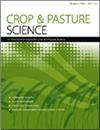解开关于雨养棉花决策中固有的农业和经济不确定性的复杂组合
IF 1.9
4区 农林科学
Q2 AGRICULTURE, MULTIDISCIPLINARY
引用次数: 0
摘要
本文章由计算机程序翻译,如有差异,请以英文原文为准。
Untangling the complex mix of agronomic and economic uncertainties inherent in decisions on rainfed cotton
ABSTRACT Context. Production of rainfed (dryland) cotton (Gossypium hirsutum L.) occurs in many places globally, and is always burdened with greater uncertainties in outcomes than irrigated cotton. Assessing farm financial viability helps farmers to make clearer and more informed decisions with a fuller awareness of the potential risks to their business. Aim. We aimed to highlight key points of uncertainty common in rainfed cotton production and quantify these variable conditions to facilitate clearer decision-making on sowing dates and row configurations. Methods. The consequences of these decisions at six locations across two states in Australia, given estimates of plant-available water at sowing, are expressed in terms of comparable probability distributions of cotton lint yield (derived from crop modelling using historical weather data) and gross margin per hectare (derived from historical prices for inputs and cotton lint yield), using the copula approach. Examples of contrasting conditions and likely outcomes are summarised. Key results. Sowing at the end of October with solid row configuration tended to provide the highest yield; however, single- and double-skip row configurations generally resulted in higher gross margins. Places associated with higher summer-dominant rainfall had greater chance of positive gross margins. Conclusion. In order to maximise the probability of growing a profitable crop, farmers need to consider the variabilities and dependencies within and across price and yield before selecting the most appropriate agronomic decisions. Implications. Given appropriate data on growing conditions and responses, our methodology can be applied in other locations around the world, and to other crops.
求助全文
通过发布文献求助,成功后即可免费获取论文全文。
去求助
来源期刊

Crop & Pasture Science
AGRICULTURE, MULTIDISCIPLINARY-
CiteScore
4.20
自引率
15.80%
发文量
111
审稿时长
3 months
期刊介绍:
Crop and Pasture Science (formerly known as Australian Journal of Agricultural Research) is an international journal publishing outcomes of strategic research in crop and pasture sciences and the sustainability of farming systems. The primary focus is broad-scale cereals, grain legumes, oilseeds and pastures. Articles are encouraged that advance understanding in plant-based agricultural systems through the use of well-defined and original aims designed to test a hypothesis, innovative and rigorous experimental design, and strong interpretation. The journal embraces experimental approaches from molecular level to whole systems, and the research must present novel findings and progress the science of agriculture.
Crop and Pasture Science is read by agricultural scientists and plant biologists, industry, administrators, policy-makers, and others with an interest in the challenges and opportunities facing world agricultural production.
Crop and Pasture Science is published with the endorsement of the Commonwealth Scientific and Industrial Research Organisation (CSIRO) and the Australian Academy of Science.
 求助内容:
求助内容: 应助结果提醒方式:
应助结果提醒方式:


